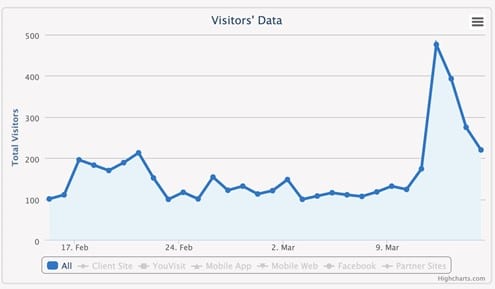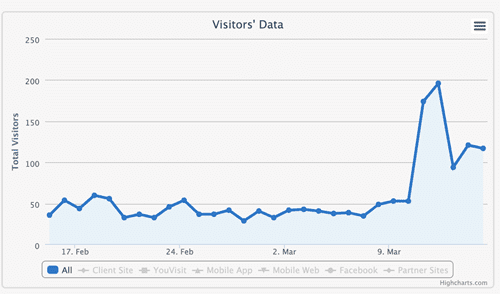It’s a uniquely challenging time for those of us who think about enrollment marketing strategy. With the COVID-19 pandemic still unfolding across the country and the globe, it’s a safe bet that conventional assumptions about student and parent behavior will no longer hold.
Many practitioners wonder whether high school students or their parents are even prepared to be thinking about colleges right now, since their lives and daily routines have almost certainly been upended.
In search of answers, I reached out to a colleague on our YouVisit team to see if one indicator of prospective student engagement—traffic to virtual tours—has changed across the past several weeks.
Virtual tour traffic up
Our YouVisit analyst provided the charts below, which represent visitor web traffic data for two specific schools’ virtual tours from the middle of February 2020 until today. As the coronavirus pandemic swept across the country, these two colleges saw a significant spike in virtual tour traffic over the span of several days.


This suggests a phenomenon I have observed firsthand as a parent of two teenagers: many high school students suddenly have less to do than they expected, and a good number of them are spending their newfound free time exploring colleges and considering their future options.
Still, even if students (and parents) are continuing to participate in the college search journey during this time, should we alter our approach to engaging them?
It’s hard to say for certain, because much will continue to change, but we have developed six strategic principles to guide the enrollment marketing work we do with our partners.
1. Don’t overcorrect
In conversations with partners over the past week, we have found that in some cases, their first instinct was to shut off marketing altogether. We believe that is not the best course of action.
Subscribe to the Daily Briefing
Get our latest COVID-19 resources and insights delivered to your inbox
SUBSCRIBE NOWWhile some messages will need to shift, particularly those related to logistics and deadlines, the essential steps in the prospective student journey—engaging students in the consideration process, driving them to apply, and supporting their decision to attend—remain as relevant as ever. Colleges that go silent this spring risk doing long-term damage to their enrollment funnels, reducing the size of their inquiry pools in a way that could take years to correct.
What’s more, we have been doing a broad review of campaign messaging across our partners in light of today’s environment, and our read-overs suggest that the vast majority of our partners’ emails, display ads, print mailings, and even text reminders are just as appropriate during a time of widespread disruption as they have ever been.
A coworker recently shared another piece of evidence to support the proposition that enrollment marketing communications, broadly speaking, remain relevant and acceptable: our team that monitors student “replies” to email campaigns reports no change in the volume or nature of student responses across the past week, even after the coronavirus situation spurred school closures and schedule disruptions.
2. Prioritize yield-related marketing
Since enrollment teams need to focus their scarce resources, we recommend that they (and we) spend time first on the activities most likely to yield students for the entering class of fall 2020.
Among all prospective students in the enrollment funnel, the set of admitted-but-not-yet-deposited students have the strongest relationship with the school they are considering attending; influencing their decision whether to attend will have the biggest impact on near-term fortunes of any marketing intervention.
Notably, our partners with YouVisit virtual tours have already been promoting those tours more aggressively to admitted students this year, a focus that seems wise and should continue as in-person tours remain infeasible.
3. Invest in the “inbound” experience
As the virtual tour traffic data above suggests, when prospective students have less structured time and more travel restrictions, they’re more likely to be on the Internet exploring—which means that they are even more likely to find you on the web.
This is a great time to enhance a virtual campus tour if you have one or create a virtual tour if you don’t; according to the producers at YouVisit, it’s possible to do either with existing video footage. It’s also more important than ever to ensure that your school’s website provides a welcoming experience for prospective students.
4. Keep everyone up to date
Many of the questions that prospective students and families are asking right now are about how processes, events, and timelines are going to change.
It’s important to make sure that all your communications, across all channels, reflect the most recent decisions that you have made. At least one EAB partner institution is taking this imperative one step further by creating a comprehensive “Virtual Admissions” microsite that compiles all “coronavirus-era” updates in one place.
5. Don’t forget about the long term
Enrollment leaders could be forgiven for focusing on the here and now, given everything they are contending with. But at least a fraction of their mindshare needs to be reserved for what comes months and years down the road. Leaders need to carve out time and mental energy for themselves and their teams to plan for the long term, even as immediate priorities clamor for their attention.
6. Put students and parents first
With all the uncertainty that students and parents are experiencing, the best thing that enrollment teams can do is to apply empathy to everything they’re involved in, including marketing and communications.
For instance, a number of partner institutions are considering changing their deposit deadline from May 1 to June 1, but some of them were thinking that they would not change the deadline publicly, but rather would just extend the deadline a month behind the scenes and communicate the change in one-off settings. Our team’s opinion was that in these stress-inducing times, it would be a more family-friendly alternative to announce the change publicly, so that more people have more clarity that they can get deadline relief.
The only certainty: Change
Support your college through the coronavirus crisis
Visit our coronavirus resource center
View the resourcesWe are confident that no matter what else happens, those six principles will stand enrollment teams in good stead as they react to the coronavirus crisis. However, like anyone else who has been following the news lately, we are also sure that our plans will need to evolve more in the coming weeks and months.
Keeping in close touch with student and parent engagement at every stage of the enrollment funnel is critically important; likewise, so is staying abreast of what other institutions are saying and doing.
EAB just completed a survey of enrollment leaders on responses to COVID-19—one of many resources available on our coronavirus resource center. Also, please join Madeleine Rhyneer and me for a webinar about COVID-19 and Enrollment, March 19 or March 24—I look forward to hearing your perspective and sharing our latest learnings in these fast-moving times.


